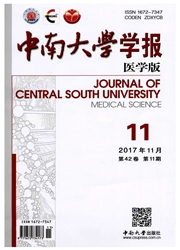

 中文摘要:
中文摘要:
目的:探讨ABC超家族转运体蛋白在CD133^+胶质瘤干细胞多药耐药性中的作用机制。方法:选取30例人脑胶质瘤标本,利用免疫磁珠法分选标本中的CD133^+胶质瘤干细胞(悬浮细胞)和CD133^-肿瘤细胞(黏附细胞),并进行分选细胞的体外扩增培养、传代与鉴定,应用免疫组化和RT-PCR法分别检测细胞中MDR1和MRP1的蛋白及其活性表达情况。结果:3例胶质母细胞瘤来源的CD133^+细胞能在含血清培养基中形成肿瘤干细胞球,并进行1~3次传代;MDR1与MRP1耐药蛋白在CD133^+细胞中高度表达,阳性细胞比例范围分别为18%~67%和23%~73%;MDR1与MRP1在CD133^+细胞中的表达活性分别为在CD133^-细胞中的16.1倍和19.6倍;多药耐药蛋白的阳性细胞比例和其表达活性与肿瘤的恶性程度呈正相关,而表达阳性率与肿瘤的病理级别无关;MDR1与MRP1在CD133^+细胞中的表达有明显的相关性。结论:神经上皮肿瘤中仅有小部分细胞亚型(CD133^+胶质瘤干细胞)具有内在耐药性(天然耐药性),而ABC超家族转运体蛋白MDR1与MRP1在CD133^+胶质瘤干细胞中的共同过度表达是胶质瘤多药耐药的主要原因之一;CD133^+细胞是胶质瘤化疗的关键性治疗标靶。
 英文摘要:
英文摘要:
Objective To explore the muhidrug resistance ( MDR ) mechanism of ABC superfamily transporters in the tumor stem cells (TSC) from human brain glioma tissues. Methods Sam-ples of glioma were obtained from 30 patients undergoing microsurgical tumor resection. The CD133^+ cells and CD133^- cells from these tumor specimens were isolated by magnetic activated cell sorting ( MACS ). These cells were cultured, proliferated and passaged. The protein and acti-vity expression of multidrug-resistance protein 1 ( MDR1 ) and muhidrug-resistance associated protein 1 ( MRP1 ) were analyzed between CD133^+ and CD133^- cells by immunocytochemistry and RT-PCR respectively. Results CD 133^+ cells generated free floating neurosphere-like brain tumor spheres ( BTS ) and abnormal proliferating capacity in the serum-free medium (SFM) in vitro. Three cases from glioblastoma stem cells could form BTS in the complete medium, and could be cultured for 1 -3 passages. The range of positive cell proportion for MDR 1 and MRP1 expression in CD 133^+ cells was 18 % 67% and 23% -73 % respectively. The expression levels of MDR1 and MRP1 mRNA were higher in CD133^+ glioma stem cells than those in the differentiated tumor cells (TC) , the protein activity was increased to 16.1 and 19.6 times respectively compared with that of TC. The protein and activity expression were positively related to the pathological grades of tumors. MDR1 or MRP1 drugresistance was not expressed in all the tumors, and there was obvious correlation between MDR1 and MRP1. Conclusion Only a small proportion of cells in the heterogeneous glioma is CD133^+ brain tumor stem cells which display the strong capacity of self-renewing, abnormal proliferation and intrinsic muhidrug resistance to traditional chemotherapy. The high expression of MDR1 and MRP1 by the CD133^+ brain tumor stem cells is one of the main mechanisms in the chemoresistance of tumors. CD133^+ brain tumor stem cells can be served as the root of multidrug resistance a
 同期刊论文项目
同期刊论文项目
 同项目期刊论文
同项目期刊论文
 期刊信息
期刊信息
